The sense of a person has wider contours
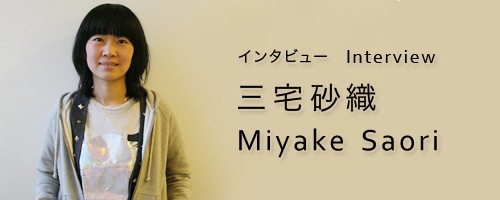
The VOCA exhibition presents two-dimensional works by promising contemporary artists up to the age of forty nominated by members of the professional art fraternity. We talked to 2010 VOCA Prize winner Miyake Saori about her unconventional practice and mode of expression.
Interview/text: Matsuura Naomi
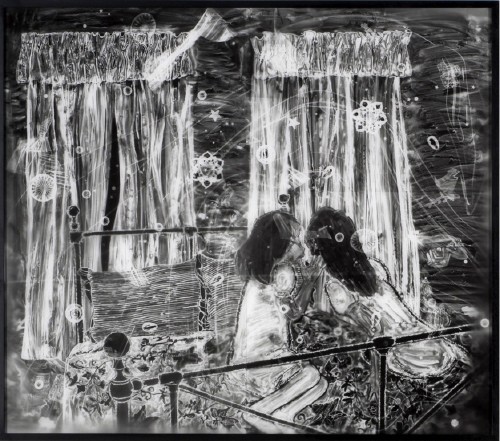
a secret talk 2009
Gelatin silver prints, 145x165x5cm, Photo Ueno Norihiro
VOCA Prize winning work
– Your works, which could be likened to dreams projected on a starry sky, look like drawings in white on black; I imagine many are surprised to discover they’re photographs produced using the photogram technique. Can you start by explaining your method?
Photograms are distinguished by the absence of a camera. The object is placed directly on photographic paper and light directed at it to cast a shadow, from which an image is obtained. I suppose you might call it a primitive form of photography. I draw in black on clear film, then place the film on photographic paper and expose it. The positive and negative are reversed; the parts drawn in black becoming white, and those left blank turning black. I experiment in various ways with each lot of film, such as altering where I direct the light, or jiggling the films; trying ten or so different things. The image only becomes apparent in the developing fluid, so while trialing different effects I can make adjustments in a fairly organic sort of way.
– By ‘each lot of film’, do you mean you use several layers of film with pictures to produce a single work?
It’s not possible to expose each film separately, so I layer between three and seven films for each and expose them together.
Keeping a distance from the frame
– I understand you majored in printmaking at university. Your early efforts were dominated by prints and painted works; would you say you then made a gradual shift to something in between prints and paintings, before finally arriving at photographs?
My gateway to art was through Nihonga. When painting I never knew at what point a work was complete, and felt they were always too close to me to see clearly. Thus I chose printmaking because it requires the acts of making the plate, and printing off it, which I thought would allow me to put distance between the work and myself. I decided on lithography, a technique that lets you produce prints in a manner that feels similar to painting, and one day I had the opportunity to experiment with a method employing a handdrawn film directly as a silkscreening stencil. So I drew, on film, the picture that is the preliminary stage in making a printing plate, thinking that if I burned it onto photographic paper it might result in a photographic work. The basic action is that of drawing, however with photos one never knows exactly what the final image will look like until it is revealed in the developing fluid. So in terms of putting distance between work and self, I think what I do is draw while looking far ahead.
Senses such as hearing and sight dotted around in mid-air
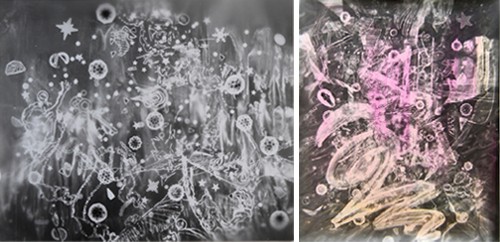
Left: Air 4 2008 Gelatine silver print, 36.5×44.5cm
Right: color of the air/pink 2009 Gelatine silver print, color ink, 61×50.8cm
– In the catalog for 2008’s LOCUS exhibition you state that the theme of your practice is one of ‘dissimilating and assimilating perceptions and emotions’.
Perceptions and emotions interact, and I’m interested in the fluidity and multilayered nature of this relationship. If perceptions are an agglomeration of point-like sensations resembling stars in the sky, emotions I believe are the products of our imagination, like the constellations.
– Looking back we first find points appearing with your lithographs of 2002-03. What drove you to render your ideas by joining dots of various sizes?
I’ve always liked lines, and my object was to draw good contour lines. But at some point it struck me that for instance, one can trace the outline of a person, but the sense of that individual actually has broader contours. This prompted me to rethink my approach to drawing contours, and outline in dotted lines those parts unable to be marked off completely in solid lines. I was fascinated by the way round dots, being ambiguous in orientation, connect in unexpected directions. Making a copy entirely in dots I find the original image becomes blurred, the spatial continuity muddled, with things sometimes connecting in different ways. Which fits with the idea of constellations.
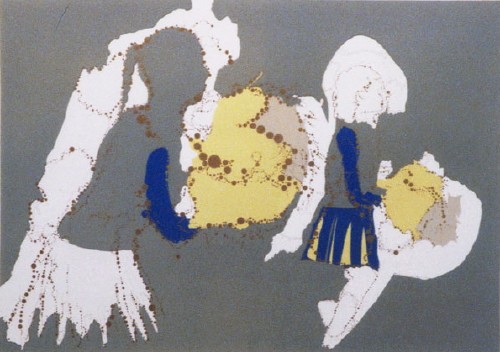
Cheer Leaders 2 2003
Lithograph, 39x53cm
– Is this also connected to your later works using rhinestones?
It is. Although I used to call them ‘points of consciousness’. To me it seemed that senses more removed from the body than skin sensation, say hearing and sight, hover in mid-air, so I show them using rhinestones.
– How do you choose your motifs? Living spaces such as bedrooms, with or without young women…
Both living spaces and young women are familiar territory for me, and thus easily portrayed. To disguise the strokes of the brush as something else I decide that cloth of some sort, something layered like pleats, would be suitable, and draw items in the house that have lots of fabric, like beds and curtains.
Casting off limitations to make ideas reality
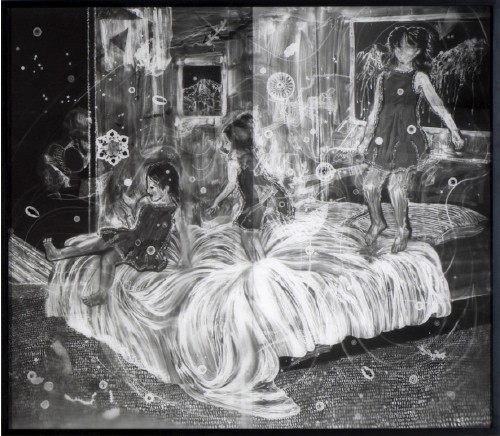
Bed 2009
Gelatin silver prints, 145x165x5cm, Photo Ueno Norihiro
VOCA Prize winning work
– Your recent works – and this includes those that won you the VOCA prize – are freer, bolder, in both size and expression. Has something changed to prompt this?
I suspect it’s largely down to feeling more comfortable casting off limitations to make my ideas reality. Plain technical improvement comes into it as well: I’m now able to work in a fairly relaxed way. The two works that won the VOCA prize were made by joining two sheets together, because photographic paper has a limited width. Here I endeavored to incorporate the different gradations of light and dark around the join into the work, and also utilized the lines marking the edges of the films on which I drew the pictures.
– In other words you took the size limit of the photographic paper and turned it to your advantage. What’s on the horizon now? It struck me you might be keen to give installations a go.
I’d like to expand the viewer’s perspective, to extend it’s range, so I’ve been experimenting with things like placing works on the floor and incorporating different materials, to present them in a slightly more three-dimensional way. I imagine I’ll continue with paintings and drawings, including photograms, but perhaps try my hand at other media as well. I’m willing to give anything a go if opportunity and ideas arise. Already I’ve tried a little hand-coloring on photograms, and who knows, maybe I’ll decide to get my pictures moving.
Miyake Saori
Born 1975 in Gifu. Winner of the 2010 VOCA Prize. Began studying Nihonga painting in high school; majored in printmaking at Kyoto City University of Arts. Uses lithography, silkscreen, and photogram techniques combined with finely rendered linework to create dreamlike images. Recent group shows include Exhibition as media 2008 [LOCUS] (Kobe Art Village Center); recent solo shows include CONSTELLATION 2 (2009, Yuka Sasahara Gallery, Tokyo). She will be exhibiting at The Vision of Contemporary Art (VOCA) 2010 (14 – 30 March, the Ueno Royal Museum, Tokyo). In the planning are a solo show at lammfromm (13 March – 20 April, Tokyo), and work for ART OSAKA (9 – 11 July, Dojima Hotel) with FUKUGAN GALLERY.
